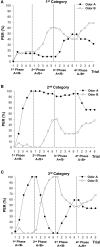Multiple reversal olfactory learning in honeybees
- PMID: 20700501
- PMCID: PMC2917220
- DOI: 10.3389/fnbeh.2010.00048
Multiple reversal olfactory learning in honeybees
Abstract
In multiple reversal learning, animals trained to discriminate a reinforced from a non-reinforced stimulus are subjected to various, successive reversals of stimulus contingencies (e.g. A+ vs. B-, A- vs. B+, A+ vs. B-). This protocol is useful to determine whether or not animals "learn to learn" and solve successive discriminations faster (or with fewer errors) with increasing reversal experience. Here we used the olfactory conditioning of proboscis extension reflex to study how honeybees Apis mellifera perform in a multiple reversal task. Our experiment contemplated four consecutive differential conditioning phases involving the same odors (A+ vs. B- to A- vs. B+ to A+ vs. B- to A- vs. B+). We show that bees in which the weight of reinforced or non-reinforced stimuli was similar mastered the multiple olfactory reversals. Bees which failed the task exhibited asymmetric responses to reinforced and non-reinforced stimuli, thus being unable to rapidly reverse stimulus contingencies. Efficient reversers did not improve their successive discriminations but rather tended to generalize their choice to both odors at the end of conditioning. As a consequence, both discrimination and reversal efficiency decreased along experimental phases. This result invalidates a learning-to-learn effect and indicates that bees do not only respond to the actual stimulus contingencies but rather combine these with an average of past experiences with the same stimuli.
Keywords: honeybee; learning; multiple reversal; olfaction.
Figures





Similar articles
-
GABAergic feedback signaling into the calyces of the mushroom bodies enables olfactory reversal learning in honey bees.Front Behav Neurosci. 2015 Jul 29;9:198. doi: 10.3389/fnbeh.2015.00198. eCollection 2015. Front Behav Neurosci. 2015. PMID: 26283938 Free PMC article.
-
Successive olfactory reversal learning in honeybees.Learn Mem. 2002 May-Jun;9(3):122-9. doi: 10.1101/lm.44602. Learn Mem. 2002. PMID: 12075000 Free PMC article.
-
Configural olfactory learning in honeybees: negative and positive patterning discrimination.Learn Mem. 2001 Mar-Apr;8(2):70-8. doi: 10.1101/lm.8.2.70. Learn Mem. 2001. PMID: 11274252 Free PMC article.
-
Invertebrate learning and memory: Fifty years of olfactory conditioning of the proboscis extension response in honeybees.Learn Mem. 2012 Jan 17;19(2):54-66. doi: 10.1101/lm.024711.111. Print 2012 Feb. Learn Mem. 2012. PMID: 22251890 Review.
-
Learning-dependent plasticity in the antennal lobe improves discrimination and recognition of odors in the honeybee.Cell Tissue Res. 2021 Jan;383(1):165-175. doi: 10.1007/s00441-020-03396-2. Epub 2021 Jan 29. Cell Tissue Res. 2021. PMID: 33511470 Review.
Cited by
-
Memory consolidation in honey bees is enhanced by down-regulation of Down syndrome cell adhesion molecule and changes its alternative splicing.Front Mol Neurosci. 2024 Jan 9;16:1322808. doi: 10.3389/fnmol.2023.1322808. eCollection 2023. Front Mol Neurosci. 2024. PMID: 38264345 Free PMC article.
-
GABAergic feedback signaling into the calyces of the mushroom bodies enables olfactory reversal learning in honey bees.Front Behav Neurosci. 2015 Jul 29;9:198. doi: 10.3389/fnbeh.2015.00198. eCollection 2015. Front Behav Neurosci. 2015. PMID: 26283938 Free PMC article.
-
Dynamically expressed single ELAV/Hu orthologue elavl2 of bees is required for learning and memory.Commun Biol. 2021 Oct 28;4(1):1234. doi: 10.1038/s42003-021-02763-1. Commun Biol. 2021. PMID: 34711922 Free PMC article.
-
Honey Bees Can Use Sequence Learning to Predict Rewards from a Prior Unrewarded Visual Stimulus.Insects. 2025 Mar 31;16(4):358. doi: 10.3390/insects16040358. Insects. 2025. PMID: 40332847 Free PMC article.
-
A Multiscale Review of Behavioral Variation in Collective Foraging Behavior in Honey Bees.Insects. 2019 Oct 25;10(11):370. doi: 10.3390/insects10110370. Insects. 2019. PMID: 31731405 Free PMC article. Review.
References
-
- Ben-Shahar Y., Thompsom C. K., Hartz S. M., Smith B. H., Robinson G. E. (2000). Differences in performance on a reversal learning test and division of labor in honeybee colonies. Anim. Cogn. 3, 119–12510.1007/s100710000068 - DOI
-
- Chittka L. (1998). Sensorimotor learning in bumblebees: long-term retention and reversal training. J. Exp. Biol. 201, 515–524
-
- Chittka L., Thomson J. D., Waser N. M. (1999). Flower constancy, insect psychology and plant evolution. Naturwissenschaften 86, 361–37710.1007/s001140050636 - DOI
-
- Davey G. (1989). Ecological Learning Theory. London: Routledge
LinkOut - more resources
Full Text Sources
Research Materials
Miscellaneous

